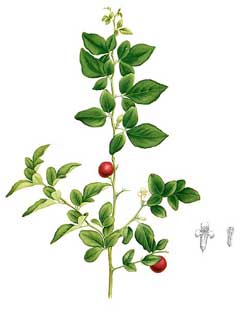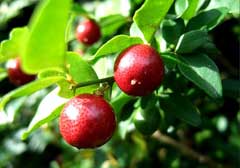 |
|
commons.wikimedia.org/wiki/File:Triphasia_trifolia_Blanco1.129-cropped.jpg |
 |
|
Translate this page:
Summary
Physical Characteristics

 Triphasia trifolia is an evergreen Shrub growing to 3 m (9ft 10in).
Triphasia trifolia is an evergreen Shrub growing to 3 m (9ft 10in).
See above for USDA hardiness. It is hardy to UK zone 10. It is in leaf all year. The species is hermaphrodite (has both male and female organs).
Suitable for: light (sandy), medium (loamy) and heavy (clay) soils and prefers well-drained soil. Suitable pH: mildly acid, neutral and basic (mildly alkaline) soils. It cannot grow in the shade. It prefers dry or moist soil.
UK Hardiness Map
US Hardiness Map
Synonyms
T. aurantiola. Lour. Limonia trifolia.
Plant Habitats
Woodland Garden Sunny Edge; South Wall. By. West Wall. By.
Edible Uses
Edible Parts: Fruit
Edible Uses: Gum
Fruit - raw or cooked[2, 105, 177, 183]. Red and fleshy[1], the fully ripe fruit has an agreeable sweet taste[1, 2]. Aromatic, juicy and somewhat mucilaginous, the fruit can also be pickled or made into jams etc[183]. The fruit is about 15mm in diameter[200].
References More on Edible Uses
Medicinal Uses
Plants For A Future can not take any responsibility for any adverse effects from the use of plants. Always seek advice from a professional before using a plant medicinally.
Antidiarrhoeal Skin
The leaves are applied to the body in the treatment of diarrhoea, colic and skin diseases[240].
References More on Medicinal Uses
The Bookshop: Edible Plant Books
Our Latest books on Perennial Plants For Food Forests and Permaculture Gardens in paperback or digital formats.

Edible Tropical Plants
Food Forest Plants for Hotter Conditions: 250+ Plants For Tropical Food Forests & Permaculture Gardens.
More

Edible Temperate Plants
Plants for Your Food Forest: 500 Plants for Temperate Food Forests & Permaculture Gardens.
More

More Books
PFAF have eight books available in paperback and digital formats. Browse the shop for more information.
Shop Now
Other Uses
Cosmetic Gum Incense
The leaves are used as an aromatic bath[61]. The leaves are used as cosmetics[240]. A gum runs from the stem[240], though the report does not mention any uses for this gum.
Special Uses
Scented Plants
References More on Other Uses
Cultivation details
Prefers a moderately heavy loam with a generous amount of compost and sand added and a very sunny position[200]. Prefers a pH between 5 and 6[200]. Intolerant of water logging[200], strongly disliking winter wet[1]. Most reports say that this species is not hardy in Britain, requiring greenhouse protection[1, 200], but one report says that a plant outdoors at Boslewick in Cornwall produces fruit[59]. Plants are sometimes cultivated for their edible fruit[183]. All parts of the plant are aromatic. The white flowers have a scent of orange blossom[245]. The leaves are covered in pellucid dots and release a resinous scent when bruised[245]. The fruits are lemon-scented[245].
References Carbon Farming Information and Carbon Sequestration Information
Temperature Converter
Type a value in the Celsius field to convert the value to Fahrenheit:
Fahrenheit:
The PFAF Bookshop
Plants For A Future have a number of books available in paperback and digital form. Book titles include Edible Plants, Edible Perennials, Edible Trees,Edible Shrubs, Woodland Gardening, and Temperate Food Forest Plants. Our new book is Food Forest Plants For Hotter Conditions (Tropical and Sub-Tropical).
Shop Now
Plant Propagation
Seed - we have no information for this species but suggest sowing the seed in a warm greenhouse as soon as it is ripe if this is possible. Otherwise sow the seed in early spring in a warm greenhouse. When they are large enough to handle, prick the seedlings out into individual pots and grow them on in the greenhouse for at least their first two winters. Plant them out into their permanent positions in late spring or early summer, after the last expected frosts. Consider giving them some protection from the cold for at least their first winter outdoors.
Other Names
If available other names are mentioned here
A-koto, Angu, Apala, Asowntem, Bamia, Bendi, Bhindee, Bhindi, Binda, Bindi, Bondo, Cantarela, Derere rechipudzi, Derere, Dheras, Dherosh, Enmomi, Fetri, Gombaut, Gombo, Gumbo, Guro, Gusha, Idelele, Ikhievbo, Ilasha, Ilo, Ka fei huang kui, Kacang bendi, Kopi arab, Kubewa, Lafeu, Lieka, Loka, Maana, Ma-lontho, Mesta, Muomi, Miagorro, Nathando, Nkruma, Obori, Ochro, Okworu, Okwulu, Otigo-iwoka, Pahari bendi, Pingpesi, Pui, Quiabo, Quimbambo, Taku, Uisul hme, Vandakai, lime berry|kasthuri dehi, orangine.
Native Range
Coming Soon
Weed Potential
Right plant wrong place. We are currently updating this section.
Please note that a plant may be invasive in one area but may not in your area so it's worth checking.
Conservation Status
IUCN Red List of Threatened Plants Status : This taxon has not yet been assessed

Growth: S = slow M = medium F = fast. Soil: L = light (sandy) M = medium H = heavy (clay). pH: A = acid N = neutral B = basic (alkaline). Shade: F = full shade S = semi-shade N = no shade. Moisture: D = dry M = Moist We = wet Wa = water.
Now available:
Food Forest Plants for Mediterranean Conditions
350+ Perennial Plants For Mediterranean and Drier Food Forests and Permaculture Gardens.
[Paperback and eBook]
This is the third in Plants For A Future's series of plant guides for food forests tailored to
specific climate zones. Following volumes on temperate and tropical ecosystems, this book focuses
on species suited to Mediterranean conditions—regions with hot, dry summers and cool, wet winters,
often facing the added challenge of climate change.
Read More
Expert comment
Author
(Burm.f.)P.Wilson.
Botanical References
200
Links / References
For a list of references used on this page please go here
A special thanks to Ken Fern for some of the information used on this page.
Readers comment
| Add a comment |
|
If you have important information about this plant that may help other users please add a comment or link below. Only comments or links that are felt to be directly relevant to a plant will be included. If you think a comment/link or information contained on this page is inaccurate or misleading we would welcome your feedback at [email protected]. If you have questions about a plant please use the Forum on this website as we do not have the resources to answer questions ourselves.
* Please note: the comments by website users are not necessarily those held by PFAF and may give misleading or inaccurate information.
To leave a comment please Register or login here All comments need to be approved so will not appear immediately.
|
Subject : Triphasia trifolia
|
|
|
|